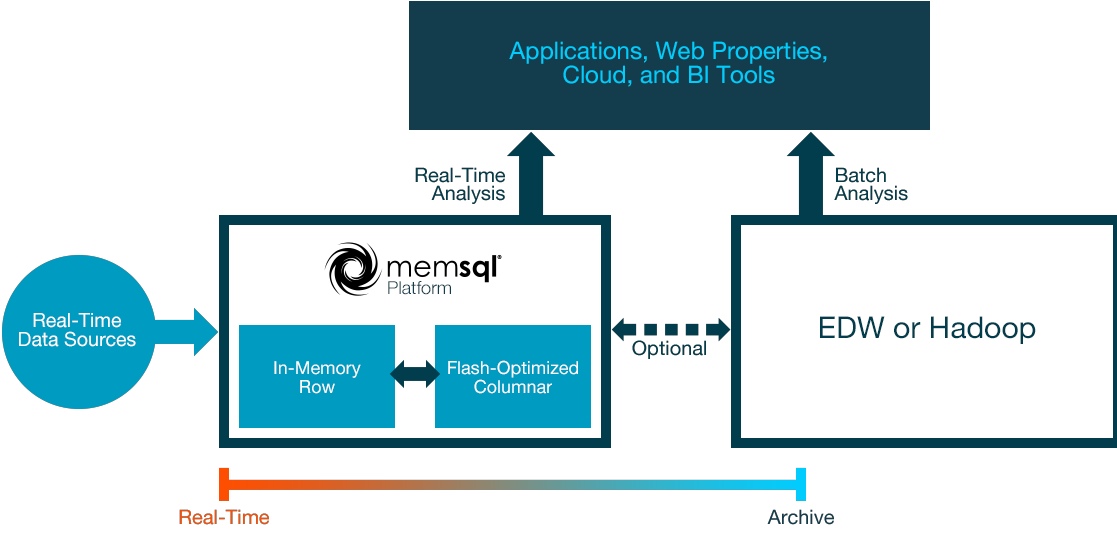MemSQL V3.0 Tiered In-Memory Database Platform
For real-time and historical data analysis
This is a Press Release edited by StorageNewsletter.com on February 11, 2014 at 2:18 pmMemSQL, Inc., in distributed in-memory database technology, announced MemSQL v3.0, which combines a fast in-memory row store with a new highly compressed column store.

This integration provides a tiered storage architecture that leverages memory for real-time transactions and analytics, and a flash-optimized column store for deep analysis.
v3.0 provides access to both storage formats through an ANSI SQL interface with built-in utilities for transferring data between formats to eliminate the costly and time-consuming extract, transform and load (ETL) process. This capability leads to shorter development cycles and reduced latency. The result is a single database for both real-time and historical data in a fast, scalable and flexible platform.
As a customer of MemSQL, CPXi has been in production with the new columnar architecture for almost six months. It is a digital media holding company providing multi-screen messaging that leverages display, social, mobile and video advertising at scale and serves billions of managed impressions daily.
“The new capabilities in MemSQL v3.0 allow CPXi to leverage historical data stores and use them to shape a real-time response,” said Gil Resh, SVP of product and technology, CPXi. “We measure online engagement over time and capture vast amounts of data-more than 250 billion records with hundreds of different dimensions-to make millisecond decisions about which ads to show, even while the webpage is loading.“
With most database offerings, organizations must use separate databases for transactions, analytical processing and data warehousing. This siloed storage approach creates separate collections of data that cannot be analyzed together without costly ETL, a slow and error-prone process. Moreover, separate data stores require engineers to develop on multiple platforms and create custom connectors for databases that were not designed for interoperability.
“Enterprises are increasingly seeking to make the smartest possible decision in the critical moment, in order to increase efficiency, reduce operational risk, and maximize income potential. Such enterprises need to leverage big data with real-time analysis of their data so they can best serve both their customers and their bottom lines,” said IDC analyst Carl Olofson. “The purpose of MemSQL v3.0 technology is to enable enterprises to process coordinated transactional and up-to-the-minute analytical workloads. This ensures data timeliness and integrity while obviating the need for complex ETL or CDC data transfers, thus saving resources and eliminating related operational delays, frustration and human error.”
v3.0 has a simplified data infrastructure that makes it possible to maintain one active dataset, allowing users and applications to conduct real-time analysis that incorporates both live and historical data. Companies can use MemSQL’s in-memory row store to ingest streaming data and run time-sensitive analytics. As data volumes grow, data can be moved to the new flash-optimized column store for highly compressed long-term storage and for deep analysis. This tiered storage architecture provides greater flexibility, and the result is a simpler, more cost-effective and less latency-prone data infrastructure.
“Our customers’ top priorities are speed and scalability,” said Eric Frenkiel, co-founder and CEO, MemSQL. “Our new flash-optimized column store means customers can combine real-time and historical data for added flexibility, extracting the full value of their data.“
Features
v3.0 features a tiered storage architecture that allows companies to combine in-memory row and flash-optimized columnar engines to capture, store and query hundreds of terabytes of data in real-time. Highlights include the following:
- Workloads can access data in both row and column stores.
- v3.0 is highly compressible – deploy in memory, flash or disk.
- Built-in utilities transfer data seamlessly between storage tiers.
- v3.0 is horizontally scalable on commodity hardware.
v3.0 will be available for download in Q2 2014.













 Subscribe to our free daily newsletter
Subscribe to our free daily newsletter

